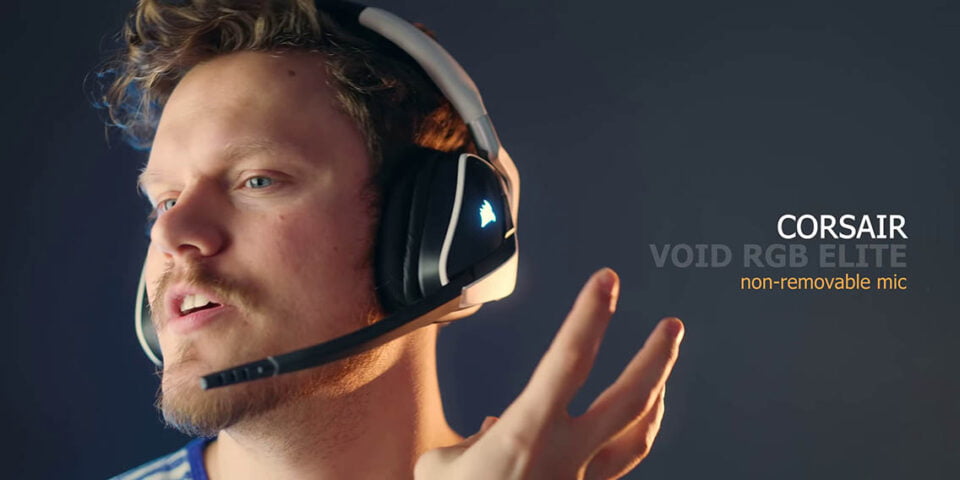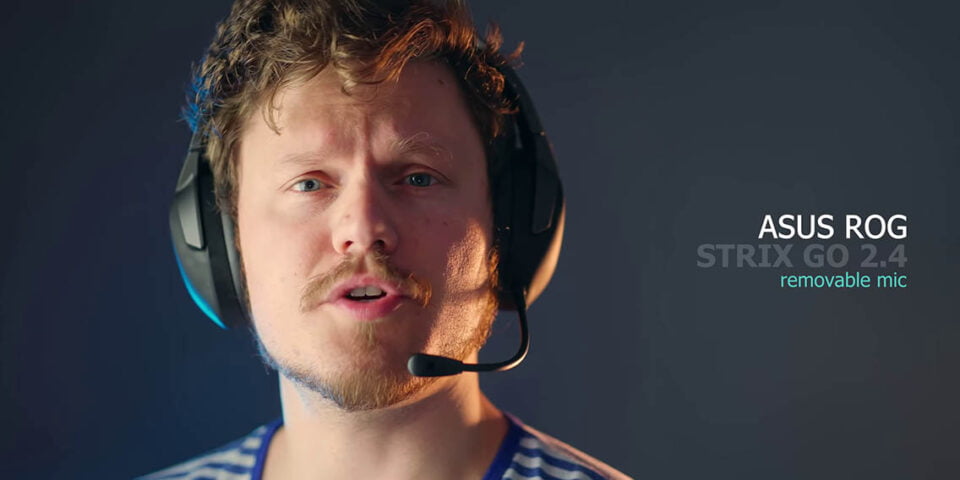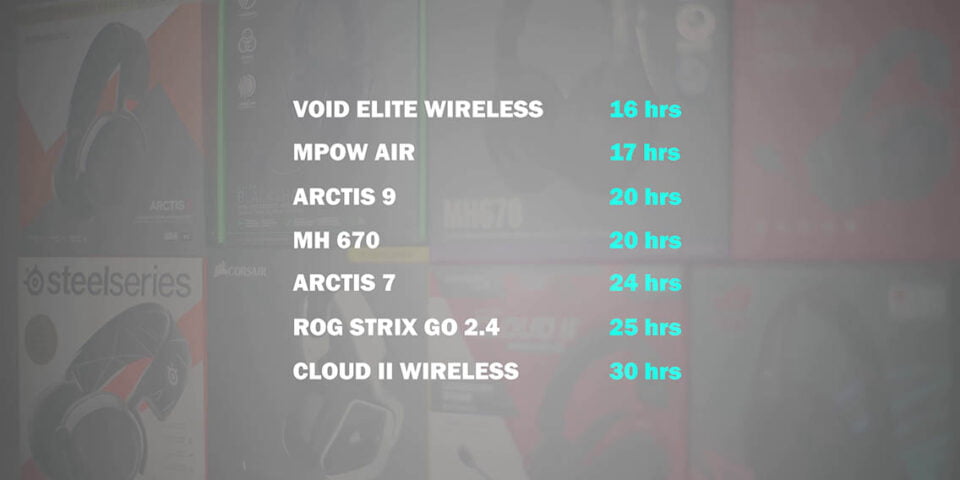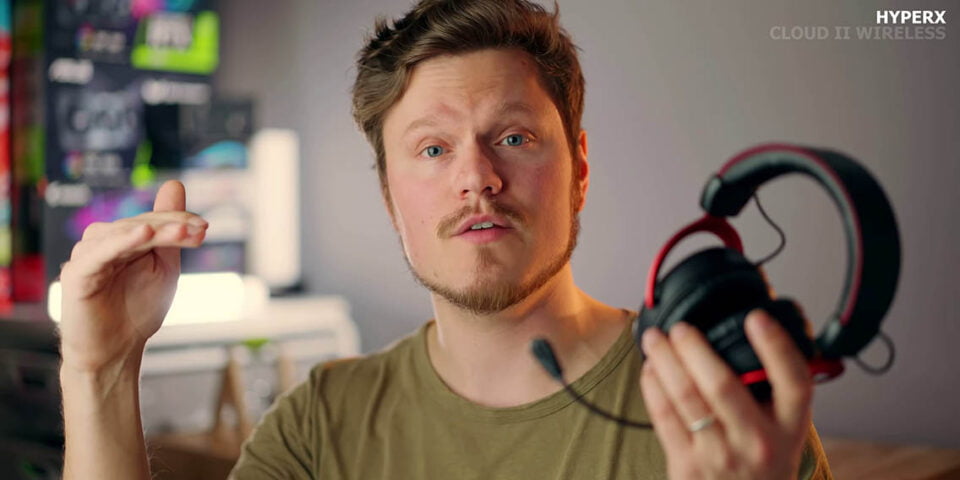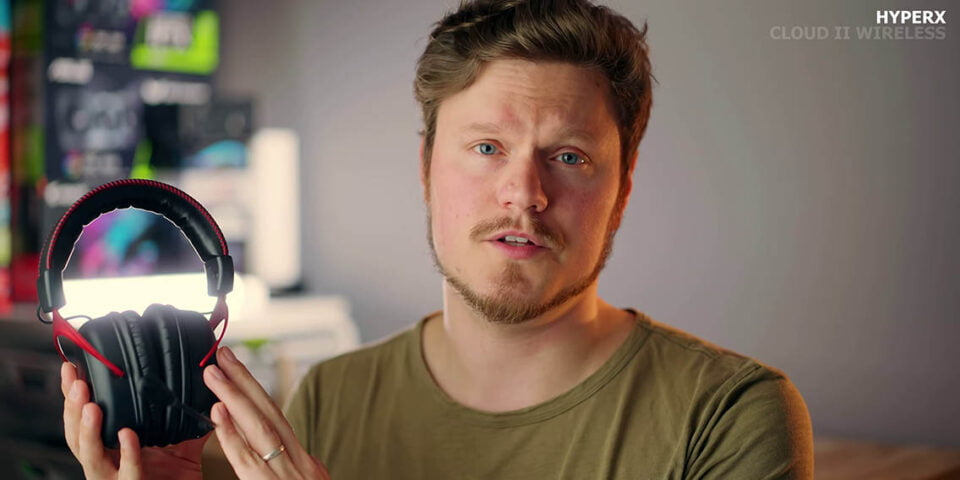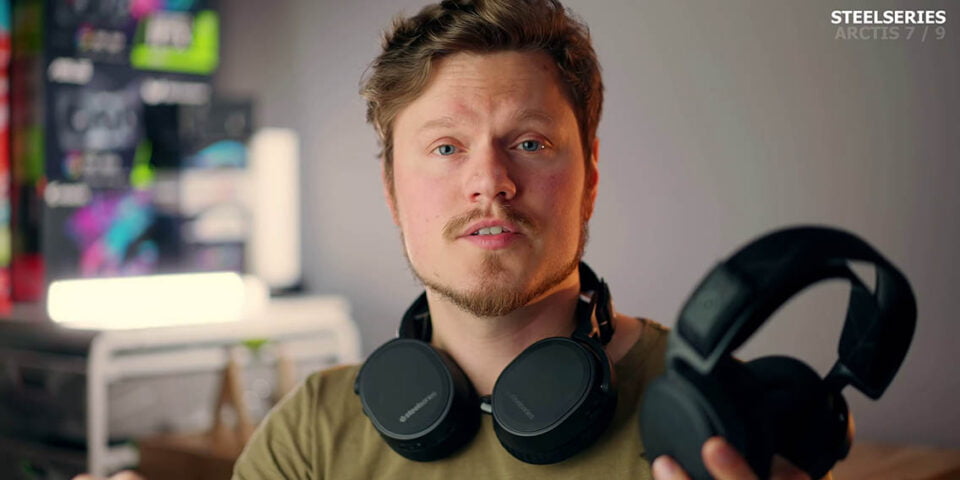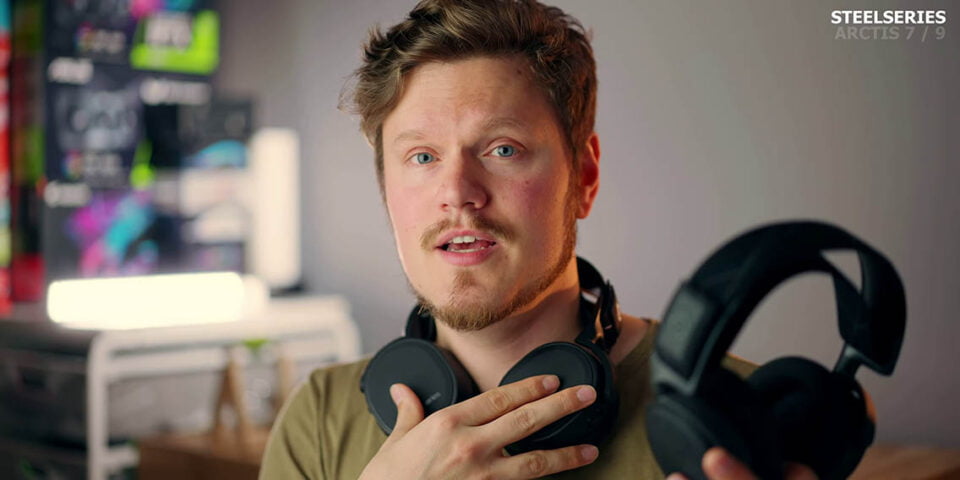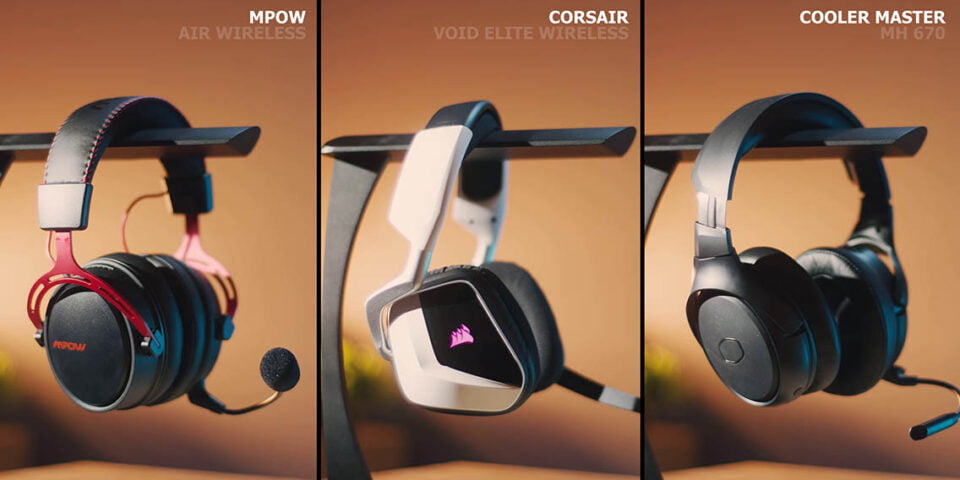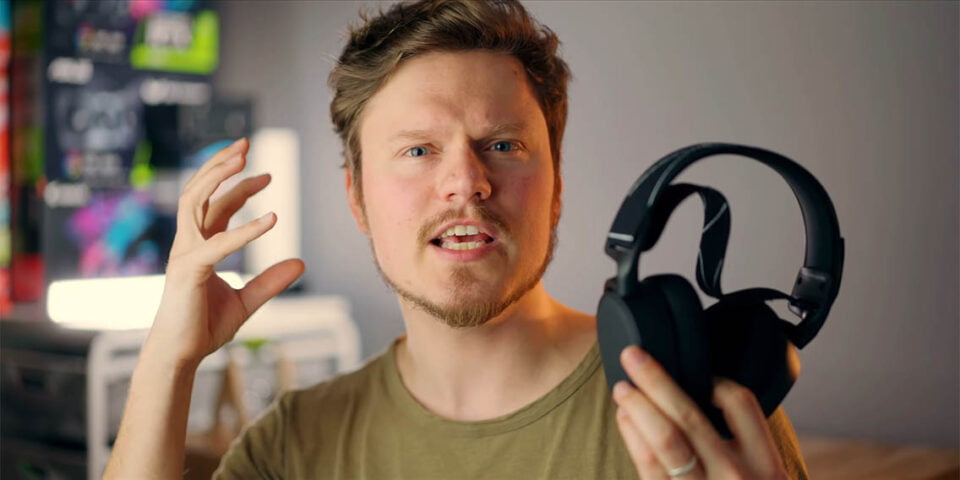
Wireless Gaming Headset Roundup – The Best in 2021
2021-07-23Table of contents
Well it’s 2021, so it’s time to do another wireless gaming headset roundup. Going wireless is all about the convenience factor of eliminating the cable clutter with some compromise on audio quality.
No wireless pair will sound as good as my Fidelio X3 with the Arc Mk2 amplifier in a gaming scenario, but there is only so much bandwidth a wireless signal can carry so let’s be real with our expectations. Having said that there is so many fantastic wireless options that they are still available in 2021, and it’s exactly what we are checking out today. Some old, some new, and some Amazon bestsellers.
These include the Corsair Void RGB Elite Wireless, the SteelSeries Arctis 7 and the new updated Arctis 9, the HyperX Cloud II Wireless, the Razer BlackShark V2 Pro, the MPOW Air Wireless 2.4GHz, the Cooler Master MH670, and the ROG Strix Go 2.4.
The only overlapping pair from our 2018 roundup is this still serious Arctis 7, just because it is still incredibly popular today. In this roundup we will cover comfort, built quality, unique features, battery life, wireless range, common issues, maybe software, and my perceived audio quality per headset based on my own experience.
First of all, this is something we want to do on a regular basis, doing similar roundups every 3 to 6 months depending on the category. I’m sure there are plenty of other wireless gems out there when it comes to audio, so let us know. Let’s outsource that research to all of you, this also applies to keyboards and mice. The first thing I want to cover is comfort and build quality, because that is a really important part of the whole convenience factor behind going wireless. Surprisingly, most of these are very well built without any plastic creaking, and all are comfortable, but 2 headsets stand out if comfort is priority #1 for you.
HyperX Cloud II Wireless
The HyperX Cloud II Wireless are the perfect combination of comfort and clamping force. It’s one of the lightest headsets too at 309 grams. It has deep enough leatherette memory foam ear cushions with interior padding. There is also a nice balance between the headband and the size extensions. It’s a staple HyperX form and it’s working very well. They don’t fold on your neck, but they aren’t choking you either. They are also perfectly fine with glasses. The controls are super intuitive where you activate the 7.1 surround mode with a single click of the power button. There is a mic mute switch too, and the volume control on the right side. Let’s also appreciate the USB-C charging.
ASUS ROG Strix Go 2.4
The second standout pair is ROG Strix Go 2.4. It is the lightest headset at 290 grams with comfy earpads and memory foam. The are more narrow versus all others, but have perfect clamping force, and they fold away on your neck and also into the headset itself. They are totally okay with glasses too. They are targeted towards mobile gamers because of their low profile design and general non-gaming vibes from a physical standpoint.
Unfortunately, the ear cup came out of the socket while doing my regular bend test. That is something that might actually happen to you if you are not careful. I was able to put it back in place, but this means that it’s the headset that I’m the most worried about in the long-term. I can imagine the ear cup just popping out if let’s say you are taking the headset off with just one hand and the whole weight is resting on that joint, and that is a big problem. They are super comfortable though, but to be honest none of the headsets in this roundup are extremely uncomfortable.
Corsair Void Elite Wireless
Next up we have the Void RGB Elite, which are very heavy at 390 grams. The clamping force is also very loose, but they fold nicely on your neck and work with glasses. The metal hinges feel robust and size extensions stay in the set positions. It’s the only pair that looks very outdated because of that angular design earcups, RGB, gloss, and non-removable microphone. Despite all of this it’s still one of the best sellers on Amazon.
Cooler Master MH 670
Next we have the Cooler Master MH670. They have really nice isolation with deep ear cushions, but they are also on the heavier side at 346 grams and I can definitely feel a lot of pressure accumulating on top of the headband. This is the only pair I would recommend for larger heads because the size extensions are massive. The fold nicely on your neck and that’s appreciated so the mic isn’t poking your face. They also pass the glasses test with a nice thumbs up.
SteelSeries Arctic 7 & Arctis 9
Next up we have the SteelSeries Arctis 7. It is just as I remember it, too smaller for my head and the fabric extension piece does not give me any extra room. I have actually told a lot of people stay clear of this design because it’s not guaranteed to fit you if you have a lot of hair or a wide head. They fold on your neck, but in this choking way where the ear cups are pressing into the neck area, and they also don’t pass the glasses test because as I move my head the ear cushions almost like grind against the temple of the glasses and generate unpleasant noises. Furthermore, I really don’t like the button layout on the ear cups. For example, the mic mute is way too close to a really loose volume wheel that I guarantee you will brush against.
Thankfully I was really happy to feel slight frame improvements on the Arctis 9, where the metal headband feels more open and will better accommodate larger heads. Also when folded on your neck the ear cups don’t choke you this time and feel just right. This also translates into a more comfortable pair for glasses where the slight reduction in clamping force makes them passable. Furthermore, I appreciate the reconfiguration of all the buttons and dials on the new model. Plus a power LED that you don’t cover with your finger when turning them on, it flashes white for the USB dongle or white and blue when Bluetooth is active. The mic mute button is also much larger now with an easy to reach volume dial above it.
MPOW Air 2.4GHz Wireless
Then we have the cheapest candidates, the MPOW Air 2.4GHz Wireless. Very much friends with the OEM of HyperX, but despite the larger ear cushions both of my ears can feel the internal driver wall. Despite the relatively heavy design at 350 grams, the balance is well distributed unlike with a cooler master pair. They do not fold on your neck so I would recommend just taking them off completely when they are not in use and they pass the glasses test just fine.
Obviously it is the color scheme with the red thread accent on the headband and the metal hinges that give away similarities to the HyperX frame, but they are probably just using the same manufacturer for these. Also, it’s a $59 USD wireless headset with a surprisingly good built quality and that is a winner in my books. The microphone on the new model is non-removable, I’m fine with that, but the mic mute button is in this really awkward place in the front on the left ear cup.
Razer BlackShark V2 Pro
Finally, we have the Razer BlackShark V2 Pro. Overall, a very comfortable design with light clamping force and a light frame at 320 grams. They have enough space for a comfortable wear around the neck, and have almost the same issue as the Arctis 7 where the padding brushes against the glasses wWhen I move my head around generating this unpleasant sound that I can hear. Unfortunately, the size extensions are not reliable, I have had so much variability in how they feel. They either have very good density or none at all, and that’s a major concern. The padding material is also very important to the overall comfort, so half the headsets have that fake leather while the other half with that more breathable, but less pleasant padding.
My one complaint when it comes to all the headsets that don’t have the fake pleather material on the ear cushions is that this bathing suit material is a bit harsh when it’s brushing against your ear. It just doesn’t sound good and it’s not pleasant either. While the fake leather material has better isolation, it feels better, but it traps more heat.
Features
Now to get some basics out of the way, every headset comes with a charging cable and a USB receiver, which is either a simple dongle or an extension like with both SteelSeries headsets that even have line-out and line-in which is really cool to extend functionality of that receiver base. While the new Arctis 9 has PC or console switch at the bottom and a connect button for the headset, just in case. By the way, quick tip, you can hide the USB dongle inside the ear cup to avoid unnecessary researching in the future. The Cooler Master pair comes with a USB-C adapter for the dongle, that’s pretty cool. The same with the ROG Strix that also comes with a carry pouch. I like the Razer cable the best because they are the soft flexible kind found on their mice. While the MPOW even has the analog 3.5mm extension to use the headset in wired mode. Only 2 in this roundup have USB-C on the headset, the Cloud II Wireless and the ROG Strix Go 2.4, the rest are micro-USB.
Every headset has an accessible volume dial, it’s just a matter of finger memory of trying to find it either on the left or the right ear cup. I like the Razer dial because it’s chunky and right on the side so easy to find, plus there is a tactile center point for precise 50% volume. The Cloud II Wireless has a really nice and smooth, easy to reach, dial, both SteelSeries pairs have a chat mix on the headset, which is probably one of the biggest reasons why this headset is so popular because it lets you control volume balance between the game and voice comms. While the dial on the MH670 is recessed way too much into the frame, making it really difficult to find and actually use. And finally, we have both the Void Elite and the ROG Strix that use this multifunction button for single-step volume control and play/pause functionality.
It’s also really cool to see all of these have the 3.5mm analog extension available, so you can use them in the wired mode, except for the Cloud II Wireless and the Void Elite RGB which are truly wireless.
Microphone Quality
All right, so now let’s do the microphone test. That Void RGB Elite is weird because it’s fairly quiet, even though all the levels are boosted 100%. Weirdly though, it sounds like the microphone capsule isn’t right beside my mouth but is somewhere else in the headset, which is strange. I do appreciate all the voice commands you hear when the microphone is muted, when you disable or enable sidetone, when this thing is going into 7.1 mode versus stereo, when you are powering on the headset or powering it off, when it’s trying to find connection, all those things are audible through a voice command and it’s nice since you are not left guessing.
Moving after the Arctis 7, this is also one of the older microphones and you can clearly hear that there’s just so much vocal compression happening. It’s exactly why wireless audio and wireless gaming headsets get bad rep because of microphones like this. The Arctis 9 is slightly more sensitive and more clear, but to be honest it’s not much better versus the Arctis 7. I will have to mention that when you mute the microphone, it does go red and the red LEDs firing right into your peripheral vision is a big annoying. If we unmute we do have a little beep, and obviously that visual indicator is something that is also available on the Arctis 7. Fom a vocal quality perspective, there is so much compression happening and it’s not good.
Moving up the chain to the Cloud II Wireless, and this one is sensitive enough, but it sounds like I’m under a desk. Why did they all have to sound so bad? It does also have that red mute LED on the microphone, fortunately it’s not as bright as on SteelSeries headsets, but you can still see it and you also get a beep in the headset.
Now we have the ROG Strix Go 2.4, and this is one of the better sounding microphones. It’s very sensitive and picks up my voice clearly. Also keep in mind that noise cancellation is enabled by the fault, it’s good if it’s trying to cancel out the background noise, but it will modify your vocal signature a bit. It still sounds better than the others.
The MPOW Air Wireless is the cheapest pair in this roundup, and it’s also the most sensitive in terms of the microphone pickup, which is good. There is no software, no gimmicks, what you hear is what you get. I really like the sound signature of this microphone, it doesn’t sound like it’s coming from the bottom of the floor.
Moving on to the Razer BlackShark V2 Pro, this one doesn’t sound like anything special to be honest, but it doesn’t have cool software tricks up its sleeve. It has different EQ profiles for the microphone, I like the Mic Boost setting since it brings everything up and still makes it a bit more clear. You can enable Noise Gate where it will not pick up certain volumes under a certain threshold. You can do Voice Clarity and also Noise Reduction, which is a bit too aggressive so I keep it off.
And finally we have the Cooler Master MH670, this one is very boomy, it’s quite sensitive, but it sounds like the microphone capsule is somewhere in the ear cup instead of being right in front of my mouth. That is disappointing considering the wired microphones on the MH675 are fantastic, and it’s just unfortunate that the wireless signal and all that compression that is happening is kind of destroying the vocal clarity that you should be expecting from this identical microphone. If you mute the microphone the LED at the bottom will flash red and green. Keep that in mind because if it’s blinking and your microphone is not working you know why.
Battery Life
As for battery life, the range here is between 16 hours on the Void Elite and up to 30 hours on the Cloud II Wireless. All are fairly quick to recharge within 2 and 3 hours, so that’s good in my books, and even at that minimum 16 hours of playtime with the Void Elite at least for my gaming style that is at least 3 days of use so I’m perfectly fine with that. I have been using the Cloud II Wireless for last 2 months or so, and that at 30 hours allows me to go like a whole week without needing to recharge it.
I appreciate the precise battery status on the HyperX software suite as well, the same thing with iCUE, but it’s in the settings tab so not exactly visible. The SteelSeries Engine only gives battery bars that I found to be not precise at all. The same with Razer Synapse because the battery capacity symbol is so tiny its useless. There is no battery meter on the Cooler Master pair even though there us drivers for it. While in the ROG Strix headset there is no way to check the battery capacity, nor is that possible with the MPOW Air since it doesn’t actually come with any software.
Wireless Range
As for wireless range, the best one goes to SteelSeries in my testing. Both the Arctis 7 and 9 some form of range 10 meters away from the dongle with multiples walls in between, experiencing some interruptions and like connection losses but still being able to deliver some form of audio, whereas everything else would just complete the cutoff. With the Strix Go 2.4 it was weird because it still reached the same 10 meter distance as the SteelSeries, but it required me to face a certain direction for the signal to reestablish back into the headset. The MPOW Air also had really impressive range, at 10 meters I had a connection but whenever I would experience interruptions my right ear cup would lose audio while the left one was like really heavily muted. The Cloud II Wireless did not exactly have the range of the SteelSeries, at 10 meters it was not pick up anything, while at 8 meters I would still experience some interruptions and it would be like a seamless on and off experience. Like if you are in the range it would start playing music, but if you leave the range it was just complete the dropout without even receiving those like really broken packets of audio that that you can hear with all other headsets.
With the BlackShark V2 Pro I would experience audio interruptions at 6 meters, so at lot less range than the others, and they would completely the cutoff at 8 meters. The Cooler Master MH670 had the worst range, it would cut off the audio just outside my office with the door closed, where all other headsets were playing back just fine. Also whenever a connection was reestablished it would take like 3 seconds for audio to start playing back. It’s the same story with the Void Elite, it had bad range, but when the connection was reestablished it would play instantaneously without you having to wait as long as you would with the Cooler Master pair.
Sound Quality
Now it’s time to talk about sound quality. In my opinion, the Cloud II Wireless has the best and most neutral sound out of this entire roundup. When you bring up the volume it brings up everything with good balance. It’s not too open soundstage wise, the highs are smooth, the bass is pleasant and surprisingly deep, the surround mode is done well by expanding the soundstage giving you a little bit of reverberations, but not aggressive. You don’t experience any muffling of the mid-range that you normally would experience with like surround modes in general, but it’s actually done very well here. Plus they isolate very well, keeping you in game.
The Black Shark V2 Pro is next with a slight V-shaped curve, still a very pleasant sound signature with more dominant bass, but it’s actually slightly tighter on the Cloud II Wireless. The highs are sharp without introducing any distortion at higher volumes, but I would not consider them to be smooth. Walking too much on the glass in the factory in Escape From Tarkov would introduce some fatigue unless you lower the volume or playing around with the EQ in the software.
Next up we have the Cooler Master MH670, these have so much power behind them, more than what I’m comfortable with even at 50% volume. They have a very pleasant open soundstage, which is kind of cool to experience from a closed wireless headset. The downfall here is the bass, it is very airy, almost non-existent and the highs are too conservative without giving you the sibilance that you want to hear in environments where you really want those details. I would not use it this for competitive stuff, but the sound signature is overall relaxed, good for open-world games, especially because of that naturally open soundstage. However, none of the EQ settings that that was playing around with recovered some of that high-end that I really want in a gaming headset, but that is just my preference. Otherwise they will be pretty suitable for most genres of games, unless you are really strictly into FPS.
Moving up to the MPOW Air, so this one is impressive from all the characteristics in terms of build, microphone, and features, but the sound quality for a $59 wireless headset is very impressive. It is actually the most powerful headset here, at 30% volume I am completely satisfied and don’t want anything louder. However, the highs are slightly harsh and I generally prefer brighter sound. The bass is almost non-existent, it’s very airy, very loose, there is no layering new, you just hear this blob of audio without being able to pinpoint what is happening in terms of instruments, in terms of depth. I played some Insurgency: Sandstorm and I couldn’t tell what was happening around me in terms of directional awareness. It’s not super bad, but if you want that competitive advantage of understanding the depth and the height of the layering of the audio I wouldn’t recommend these.
The ROG Strix was also quite disappointing out of the box, and that’s upsetting because it’s the most expensive pair in this roundup. It had a very flat representation of audio, the mid-range was also quite weird because it sounds like the vocals are outside of the headset and you can’t really hear where the vocals are placed in the space. Fortunately, there is some potential through the Armoury Create software. The gaming preset brings everything to life, and the reverb slider is kind of like magic to really carefully expand your soundstage. Nevertheless, this would not be my first pick for a wireless audio.
For example, the hideous Void Elite sound a bit more pleasant with much better mid-range that is more forward with a lot more detail. The bass is s also quite loose and airy, but they are quite smooth on the high-end so that is a really relaxed sound signature, quite similar to what we experienced with the MH670. The highs here could use a little bit of boost, but generally I left satisfied after playing some Crysis.
The last 2 pairs are the Arctis 7 and 9, they have very similar sound profiles to each other, leading towards the brighter extension with natural bass response, which is great. It’s pleasant across all the games I’m playing right now, but I would still prefer the Arctis 9 because of cleaner and slightly warmer high-end.
And so if I was to generalize them in tiers, in the first tier I would rate the Cloud II Wireless and the V2 Pro and the Arctis 9, the mid-range would include the Arctis 7 and the Strix Go if you tinker with EQ, and the lower tier would contain that MPOW Air, the Void Elite, and the MH670.
Issues
Finally, after weeks of using all these headsets, testing, retesting, listening to differences between the two, let’s talk about the issues shall we? The Arctis 9 has issues with Bluetooth mode on an Android device, my right ear cup would like be clicking, but if I switched to an iOS device on Bluetooth the clicking would stop, and there is no clicking when I’m using the dongle. This is a weird issue that is happening only with Android. Both the Arctis 7 and 9 also have really loose volume wheels making accidental volume adjustments super easy when putting the headset on and off. The same thing with the chat mix, if you can’t hear any audio, check your chat mix please.
The USB-C dongle on the ROG Strix Go gets warm when in use, so keep that in mind, it actually kind of warmed up my hand when it was plugged into my phone. The ears inside the ear cups do not breathe whatsoever, I had to air them out quite a few times. Also when the headset goes to sleep a quick power off and on does not actually wake up the headset. You have to physically turn off the device, wait a few seconds, turn it back on, and only then it will wake up. I have experienced random disconnects with the MH670 while playing around with a software, like the software would crash and the headset would disconnect from the dongle. I had to replug everything, power this thing back on, and everything was fine after that but it was still weird.
And finally, with the Void Elite I was listening to music, the battery was completely charged above 70%, and I heard the voice prompt about auto shutdown initiated because of low battery. Everything was fine, it just gave me the voice prompts without actually shutting down the headset. Not sure if this was an iCUE issue or a headset issue.
Conclusion
So I hope you enjoyed this roundup, and hopefully this was clear enough to help you decide which wireless headset to buy for your future needs. The Cloud II Wireless is still my #1 recommendation and the MPOW Air is quite okay as a $59 budget-oriented wireless pair. As I mentioned earlier on, if you want to give us some pointers on cool products in the wireless space, in the gaming space, whatever, that you would love for us to check out in a future roundup let us know. I would love to explore more what else is available out there aside from like the main peripheral brands.




